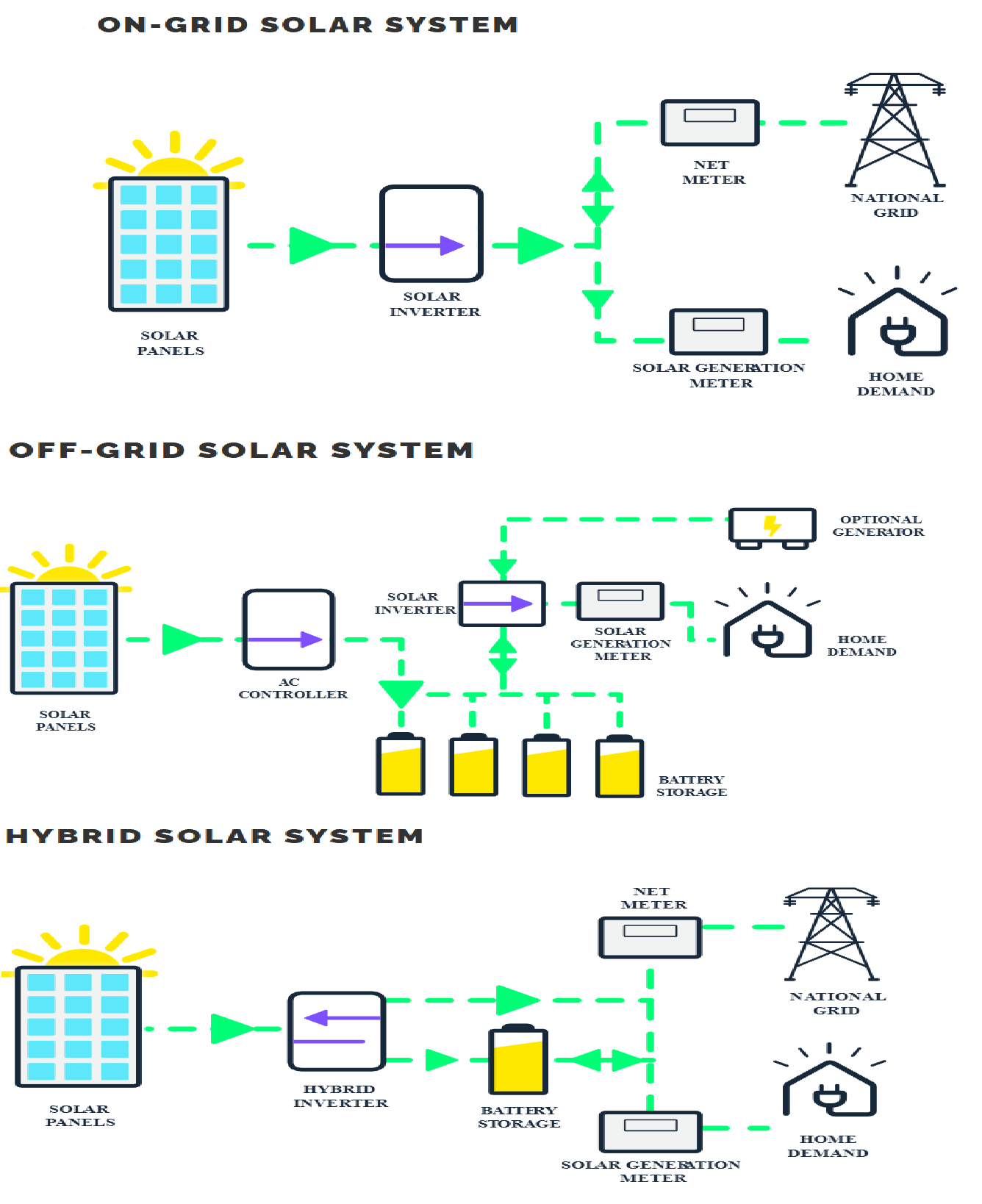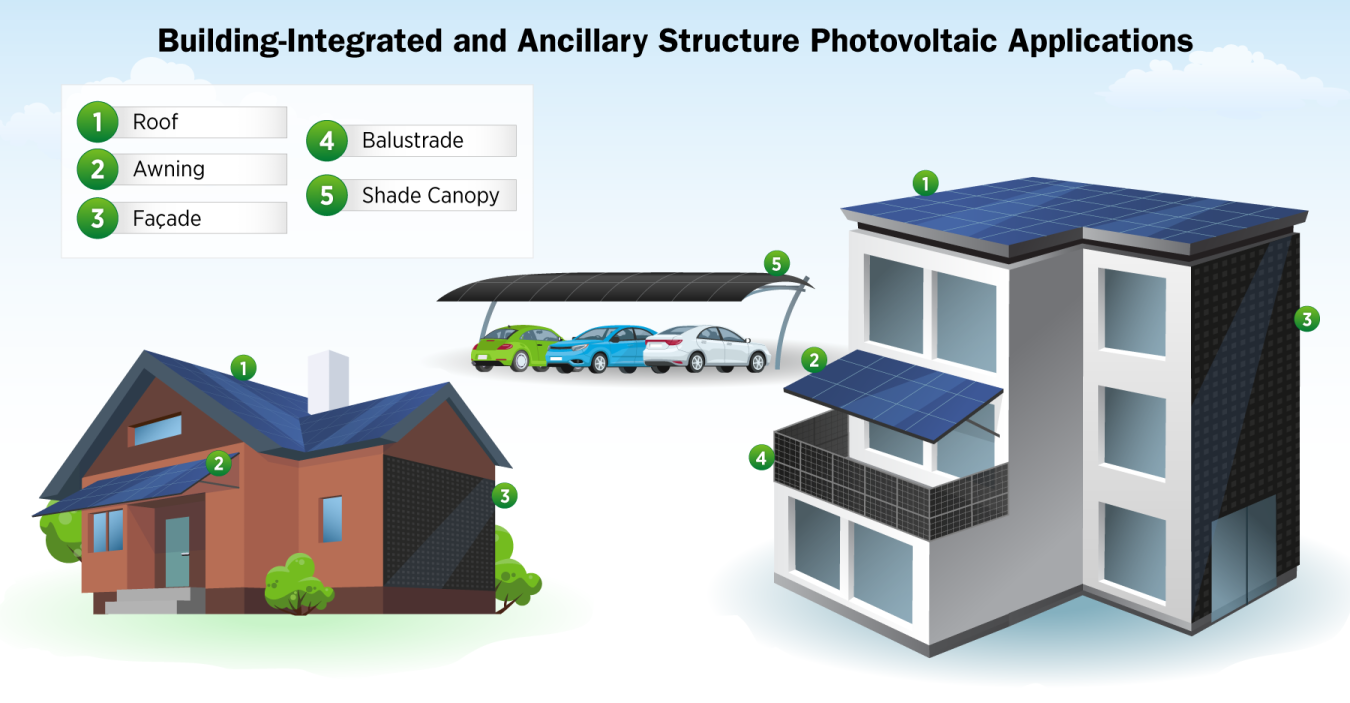Building-Integrated Photovoltaics | 04 Jun 2025
Why in News?
As India’s cities grow vertically and space for conventional rooftop solar panels becomes limited, experts are turning to Building-Integrated Photovoltaics (BIPV) as a scalable, land-neutral alternative.
- According to the World Bank, 70% of the urban infrastructure needed for India to become a developed country by 2047 is yet to be built. Integrating BIPV from the design stage can fast-track clean energy goals.
What is Building-Integrated Photovoltaics?
- About: BIPV incorporates solar energy-generating components (photovoltaic (PV) cells) directly into a building’s structure such as façades, roofs, windows, and railings, replacing conventional materials like tiles, glass, or cladding.
- Unlike traditional rooftop solar (RTS) systems that sit atop buildings, BIPV becomes part of the building’s design.
- BIPV modules generate electricity while meeting the building’s structural and aesthetic needs.
- Need of BIPV in India: Rooftop solar systems need ~300 sq. ft for 3 kilowatt (kW), but many urban homes and high-rises lack shadow-free rooftops.
- For instance, a 16-storey building may only support ~40 kWp via RTS, whereas a BIPV-integrated façade could generate up to 150 kWp.
- With the urban population projected to reach 850 million by 2051, energy demand in cities is set to soar, but RTS alone cannot bridge the gap.
- Due to space limitations, implementation delays, and low awareness, India missed its 2022 target of 40 GW RTS under the 100 GW solar goal, now extended to 2026. BIPV can help bridge this gap while supporting ecological sustainability.
- India can’t rely solely on ground-mounted and rooftop systems to meet its goal to install 300 GW of solar capacity by 2030. Land-neutral solutions like BIPV need to be prioritised.
- For instance, a 16-storey building may only support ~40 kWp via RTS, whereas a BIPV-integrated façade could generate up to 150 kWp.
- Status of BIPVs in India: Falling solar costs and rising demand for sustainable architecture are driving BIPV adoption in India.
- Notable installations include an 863-kWp system at CtrlS Datacenters in Navi Mumbai, a solar dome at the Renewable Energy Museum in Kolkata, and large BIPV setups at Vijayawada and Sahibabad railway stations highlighting BIPV’s scalability across public and commercial spaces.
- Barriers to Scaling BIPV in India: The high upfront investment required for BIPV installations remains a significant hurdle, limiting widespread adoption.
- Absence of dedicated policies and insufficient financial incentives discourage builders and developers from integrating BIPV early in building designs.
- Limited expertise in BIPV and reliance on imported technology hinder local manufacturing and deployment.
- Many stakeholders, including architects, planners, and consumers, lack awareness of BIPV benefits and applications.
Building-Integrated Photovoltaics and Traditional Rooftop Solar
|
Feature |
BIPV |
RTS |
|
Integration |
Integrated into building design |
Installed on top of the roof |
|
Functionality |
Dual-purpose (building material + power) |
Solely for energy generation |
|
Installation |
Complex, part of building design |
Easier, retrofit to existing buildings |
|
Cost |
Higher due to integration |
Relatively lower |
|
Maintenance |
Complex and expensive |
Relatively low-cost |
What is Solar Photovoltaics?
- About: Solar PV (Photovoltaic) refers to a technology that converts sunlight directly into electricity using photovoltaic cells made from semiconductor materials.
- When sunlight (photons) hits a PV cell, it excites electrons in the material, generating a flow of direct current (DC) electricity.
- Devices called inverters are used to convert this DC electricity into alternating current (AC) for use in homes and the power grid.
- Key Materials Used in PV Cells: PV cells primarily use semiconductors such as silicon, cadmium telluride, and perovskite to convert sunlight into electricity
- Conductive materials like silver and copper enable the flow of electricity, while glass provides structural support and encapsulation.
- Encapsulants like EVA (Ethylene Vinyl Acetate) and backsheets such as TPT (Tedlar Polyester Tedlar) protect the cells from moisture, dust, and physical damage, ensuring durability and efficiency.
- Types of Solar PV Systems:
- On-Grid Solar System: Connects directly to the national grid without battery storage. It powers home and exports excess energy back to the grid, reducing bills and carbon footprint.
- However, it stops working during grid outages but can be upgraded to a hybrid system by adding batteries.
- Off-Grid Solar System: Fully independent from the grid, ideal for remote locations or energy self-sufficiency. Includes batteries and often backup generators to ensure continuous power.
- Hybrid Solar System: Combines solar panels with battery storage while remaining grid-connected.
- It stores excess energy for use during the outages, offering backup power and flexibility.
- On-Grid Solar System: Connects directly to the national grid without battery storage. It powers home and exports excess energy back to the grid, reducing bills and carbon footprint.

UPSC Civil Services Examination Previous Year Question (PYQ)
Prelims
Q. Consider the following statements about PM Surya Ghar Muft Bijli Yojana: (2025)
- It targets installation of one crore solar rooftop panels in the residential sector.
- The Ministry of New and Renewable Energy aims to impart training on installation, operation, maintenance and repairs of solar_rooftop systems at grassroot levels.
- III. It aims to create more than three lakhs skilled manpower through fresh skilling, and upskilling, under scheme component of capacity building.
Which of the statements given above are correct?
(a) I and II only
(b) I and III only
(c) II and III only
(d) I, II and III
Ans: (d)
Mains
Q. India has immense potential for solar energy though there are regional variations in its developments. Elaborate. (2020)


